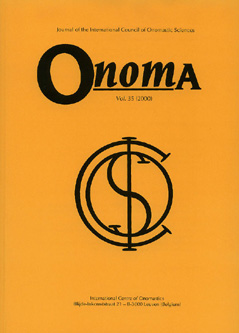 previous article in this issue previous article in this issue | next article in this issue  |

|
Document Details : Title: Toponymy and Monopoly: One Toponym, Two Parents Subtitle: Ideological Hebraization of Arabic Place-Names in the Israeli Language Author(s): ZUCKERMANN, Ghil'ad Journal: Onoma Volume: 41 Date: 2006 Pages: 163-184 DOI: 10.2143/ONO.41.0.2119615 Abstract : This article analyses toponyms that simultaneously have more than one etymon (etymological source), championing hybridity and multiple causation. Special attention is given to toponymic neologisms proposed by the Geographical Names Committee for the Hebraization of Arabic toponyms in the Negev, the southern part of Israel, in 1950-1952. It contributes towards the development of a typology of onomastic neologization in general and toponomastics in particular. Based on examples from Israel’s efforts in building and defining itself as a nation—as well as from rejective and adoptive lexical engineering by Jews throughout history—this article explores the fascinating and multifaceted relationship between names and identity. Cet article analyse les toponymes qui ont simultanément plus d’une origine étymologique, champions de l’hybridité et de la causalité multiple. Une attention particulière est accordée aux néologismes toponymiques proposés par le Comité de toponymie pour l’hébraïsation des toponymes arabes dans le Néguev, la partie sud d’Israël, en 1950-1952. Il contribue à l’élaboration d’une typologie de la néologisation onomastique en général et en particulier toponymique. Reposant sur des exemples des efforts d’Israël dans la construction et la définition d’une nation – ainsi que dans les techniques de rejet et d’adoption lexicaux par les Juifs à travers l’histoire – le présent article explore la relation fascinante et multiforme entre les noms et l’identité. Dieser Artikel analysiert Toponyme, die gleichzeitig mehr als ein Etymon (etymologischen Ursprung) und damit Hybridität sowie mehrfache Ursprünge besitzen. Spezielle Beachtung finden toponymische Neologismen, die das Geographical Names Committee for the Hebraization of Arabic toponyms 1950-1952 für das Gebiet der Negev-Wüste, dem südlichen Teil Israels, vorschlug. Es trug damit zu einer Entwicklung einer bestimmten Typolgie onomastischer Neologisierung im Allgemeinen und im toponomastischen Bereich im Speziellen bei. Basierend auf Beispiele von Bemühungen Israels, sich selbst als Nation zu konstruieren und zu definieren – es werden sowohl ausgesonderte als auch durch angenommene lexikalische Entwicklungen in der jüdischen Geschichte werden betrachtet – untersucht dieser Artikel das faszinierende und vielgestaltige Verhältnis zwischen Bezeichnungen und Identität. |
|
